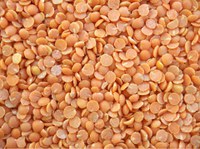Prairie Fare: 2016 is the International Year of Pulses
(Click an image below to view a high-resolution image that can be downloaded)
By Julie Garden-Robinson, Food and Nutrition Specialist
NDSU Extension Service
When someone says the word “pulse,” do you pause to feel your wrist or neck to see how fast your heart is beating?
The International Year of Pulses does not refer to that type of pulse. In this instance, pulses are foods such as lentils, chickpeas and split peas. North Dakota and Montana rank as the leading producers of these crops. Internationally, other legumes, including various dry edible beans (kidney, pinto, etc.) are included in the designation of “pulse foods.”
Eating these healthful foods is good for your heart and the rest of your body. Consuming more pulse foods may lower the likelihood of obesity and decreases blood glucose, blood pressure and blood cholesterol. Managing all of these can help protect us from heart disease.
These budget-friendly foods are used worldwide to provide nutrition. By the way, many sources indicate these nutrient-rich foods were named “pulses” because “pulse” means porridge or thick soup. Pulse ingredients are used to make these recipes.
Try these 10 questions about pulses and impress your friends with your knowledge of this upcoming “international superstar food.” The answers are listed below.
- What B vitamin is present naturally in pulse foods?
- What is another name for chickpeas?
- What pulse food usually is yellow or green? (Hint: You might like this ingredient in soup.)
- When you add fiber-rich foods such as chickpeas and lentils to your diet, what should you do to help with digestion?
- In what two food groups from MyPlate can pulses be found?
- In what two forms can you buy many pulse foods at the grocery store?
- What food component in pulses is linked to reducing blood cholesterol levels and promoting a healthy weight?
- Which ingredient can toughen pulses if added too soon in the cooking process? (For best results, add it during the last 10 minutes of cooking time.)
- What is the most popular recipe for using chickpeas? (Hint: It’s a kind of dip or sandwich spread.)
- Vegetarians usually use pulses to get enough of this nutrient in their diet. Name the nutrient.
The answers are 1) folate; 2) garbanzo beans; 3) split (or whole) peas; 4) drink more liquids; 5) Vegetable and Protein; 6) canned and dry; 7) fiber; 8) salt; 9) hummus; 10) protein.
Try some pulse foods in the coming year. We have numerous tasty recipes for you to try and handouts with more information. See the NDSU “Pulse Crops” website at https://www.ag.ndsu.edu/food/pulse-crops/publications for a variety of information.
When cooking lentils, dry peas and chickpeas, be sure to follow the cooking directions on the package. Lentils and peas do not require a soaking stage, while chickpeas do. When using canned legumes (beans, etc.), be sure to drain and rinse them. This removes up to 40 percent of the sodium.
Try some hearty, nutritious soup. Here’s a recipe featuring lentils, one of the pulse foods, courtesy of Alice Henneman, Nebraska Extension in Lancaster County. Round out a soup-based meal with whole-grain bread, sliced apples or pears and low-fat or fat-free milk.
Red Lentil Soup With Butternut Squash, Coconut Milk and Curry
1 Tbsp. canola oil
1 medium onion, chopped
1 clove garlic, chopped
2 c. dry red lentils
2 c. butternut squash, peeled, seeded and cubed into 1/2- to 1-inch pieces
4 c. reduced-sodium or no-salt-added chicken stock or broth
1 (14-ounce) can lower-fat, unsweetened coconut milk
1 (15-ounce) can diced, no-salt-added tomatoes
1 Tbsp. curry powder (or to your preferences)
1 pinch cayenne pepper
Heat oil in a Dutch oven or large skillet over medium heat. Add onion and cook until tender. Add garlic after onion is tender and cook for an additional 30 seconds. Stir in remaining ingredients. Cover and bring ingredients to a boil. Reduce the heat to low and simmer for about 15 minutes or until the squash and lentils are tender.
Makes six main-dish servings. Each serving has 200 calories, 6 grams (g) fat, 9 g protein, 29 g carbohydrate, 8 g fiber and 580 milligrams sodium.
(Julie Garden-Robinson, Ph.D., R.D., L.R.D., is a North Dakota State University Extension Service food and nutrition specialist and professor in the Department of Health, Nutrition and Exercise Sciences.)
NDSU Agriculture Communication - Dec. 24, 2015
| Source: | Julie Garden-Robinson, (701) 231-7187, julie.garden-robinson@ndsu.edu |
|---|---|
| Editor: | Ellen Crawford, (701) 231-5391, ellen.crawford@ndsu.edu |



